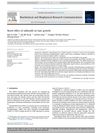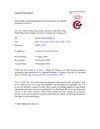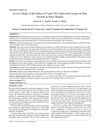TLDR Sildenafil may help with some skin conditions and hair growth, but more research is needed.
Sildenafil, known for treating erectile dysfunction, is being investigated for dermatological uses, showing promise in conditions like Raynaud’s phenomenon and lymphatic malformations due to its vasodilatory effects. It has demonstrated potential in promoting hair growth in mice and human dermal papilla cells, though results in children with alopecia areata were inconclusive. While beneficial in some skin ulcerations, its effectiveness in systemic sclerosis-related ulcers is mixed. Despite these findings, further research is needed to confirm its efficacy, and there are concerns about possible side effects, including hypersensitivity and increased melanoma risk.
 16 citations
,
October 2018 in “Biochemical and Biophysical Research Communications”
16 citations
,
October 2018 in “Biochemical and Biophysical Research Communications” Sildenafil, often used for erectile dysfunction, may help hair growth.
12 citations
,
January 2006 in “Journal of Dermatological Treatment” Topical 1% sildenafil is not recommended for treating alopecia areata in children.
 53 citations
,
February 2020 in “Expert Opinion on Pharmacotherapy”
53 citations
,
February 2020 in “Expert Opinion on Pharmacotherapy” Finasteride and minoxidil work best together for hair loss.
 16 citations
,
October 2018 in “Biochemical and Biophysical Research Communications”
16 citations
,
October 2018 in “Biochemical and Biophysical Research Communications” Sildenafil, often used for erectile dysfunction, may help hair growth.
 9 citations
,
April 2019 in “Biomolecules & Therapeutics”
9 citations
,
April 2019 in “Biomolecules & Therapeutics” Udenafil may help hair grow by activating certain stem cells.
 28 citations
,
November 2020 in “Journal of Controlled Release”
28 citations
,
November 2020 in “Journal of Controlled Release” A new hair loss treatment uses tiny needles to deliver a drug-loaded lipid carrier, promoting hair growth more effectively than current treatments.
 June 2022 in “International journal of drug delivery technology”
June 2022 in “International journal of drug delivery technology” Nebivolol cream may be a promising hair loss treatment by improving blood flow and nourishing hair follicles.





